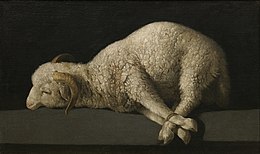
Lamb of God (Greek: Ἀμνὸς τοῦ Θεοῦ, romanized: Amnòs toû Theoû; Latin: Agnus Dei, Ecclesiastical Latin: [ˈaɲ.ɲus ˈde.i]) is a title for Jesus that appears in the Gospel of John. It appears at John 1:29, where John the Baptist sees Jesus and exclaims, "Behold the Lamb of God who takes away the sin of the world."[1] It appears again in John 1:36.
Christian doctrine holds that a divine Jesus chose to suffer crucifixion at Calvary to save the world from its sins. He was given up by divine Father, as an "agent and servant of God" in carrying away the sins of the world.[2][3] In Christian theology the Lamb of God is viewed as both foundational and integral to the message of Christianity.[4][5]
A lion-like lamb that rises to deliver victory after being slain appears several times in the Book of Revelation.[6] It is also referred to in Pauline writings; 1 Corinthians 5:7 suggests that Saint Paul intends to refer to the death of Jesus, who is the Paschal Lamb, using the theme found in Johannine writings.[7] In Genesis 22, the binding of Isaac foretells the Gospel of Jesus Christ, when Isaac asked his father Abraham "where is the lamb for the burnt offering" to which Abraham responded "God himself will provide the lamb for the burnt offering, my son." (Genesis 22:7-8). However, it was a Ram (not a Lamb) that was ultimately sacrificed in Isaac's place, and the Ram was caught in a thicket (i.e. thornbush). (Genesis 22:13). The lamb metaphor is also in line with Psalm 23, which depicts God as a shepherd leading his flock (mankind).
The Lamb of God title is widely used in Christian prayers. The Latin version, Agnus Dei, and translations are a standard part of the Catholic Mass, as well as the classical Western Liturgies of the Anglican and Lutheran churches. It is also used in liturgy and as a form of contemplative prayer.[8][9] The Agnus Dei also forms a part of the musical setting for the Mass.
As a visual motif the lamb has been most often represented since the Middle Ages as a standing haloed lamb with a foreleg cocked "holding" a pennant with a red cross on a white ground, though many other ways of representing it have been used.
- ^ Bulgakov 2008, p. 263.
- ^ Deme 2003, pp. 199–200.
- ^ Cullmann 1959, p. 79.
- ^ Gerlach 1998, p. 22.
- ^ Hoffmann 2005, p. 117.
- ^ Glabach 2007.
- ^ Chrysostom 1889.
- ^ Linman 2010, p. 148.
- ^ Marshall 1989, p. 369.